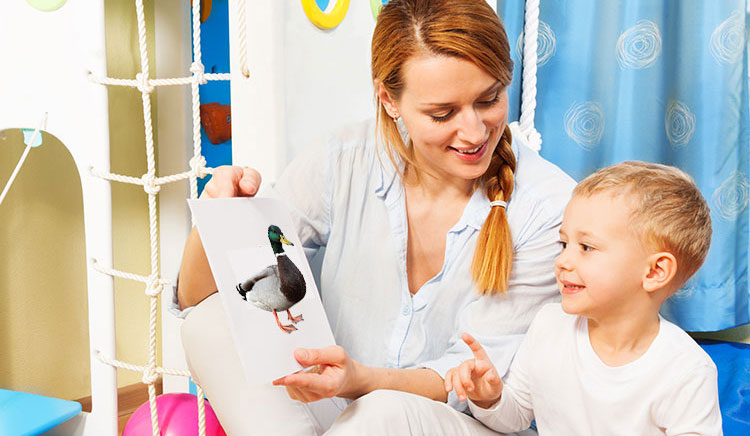A5: Sound–Source Matching
1. Overview
Match animal sounds with animal pictures, learning and practicing the skill of hearing a specific sound and matching it with its source. This game will be pretty easy for most children. It is laying the foundation for later activities, which require deeper listening skills.
A5: Sound-Source Matching
2. Materials
For this activity you will need:- A device on which to play sound clips
- Sound clips of various animal noises
- Picture cards of various animals
3. Activity
Start by going through the sounds that different animals make. One good way to do this is by singing “Old MacDonald Had a Farm.”Video: How to play Sound-Source Matching
Spread the animal picture cards out on the floor in front of the child. Next, name each animal while pointing to its picture (e.g., to make sure your child isn’t confusing “duck” and “bird”). Then prompt your child to connect the animal sound clips to the pictures:
Adult: Which animal makes this sound? [play duck sound] Child: Duck! Adult: Point to the picture of the duck. [Child points to duck.] Good. Now, which animal makes this sound? [play cat sound] Child: A cat! There! [points to cat picture] Adult: That’s right. Can you make a sound like a cat? Child: Meow, meow. Adult: Good job.↑ Top
4. Confidence Builder
- If the child has trouble finding the right picture, put out just three or four cards at a time.
- If the child has trouble recognizing the recordings of actual animal sounds, simply “say” the noises yourself. For example, say “quack quack” instead of playing the sound clip of a real duck.
5. Extension
Repeat the activity, but reduce the time you play the sound. Encourage the child to find and show the card that matches the sound before the sound stops. For parents who want to encourage musical talent in their children, you might want to try this same activity using the sounds made by a variety of musical instruments. ↑ Top6. Variation
Play the game with a storybook that features animals. While reading the book out loud to the children, substitute an animal’s name with the sound it makes. The child with the corresponding picture card should hold it up. ↑ Top7. Small Groups (2-5 children)
Lesson Objective: Children will be able to listen and match animal sounds to animal pictures. GELDS (Georgia Early Learning & Development Standards): CLL1.3a Adaptation: Read the main activity, watch the video, and follow the instructions above, with the following changes: Provide each child with an animal picture card. Go around the circle and ask each child what animal he has. Then ask, “Who says [oink, chirp, quack]?” The child with the matching picture card should hold it up and say, “A [pig] says [oink]!” Reinforcement: Talk to the animals! Have one child play Dr. Dolittle, who can talk to the animals. When Dr. Dolittle says, “Oink oink,” the child with the pig card holds it up and hands it to Dr. Dolittle. The teacher can help Dr. Dolittle by suggesting animals for her to “talk” to. Use this Reinforcement at Home form to tell parents and guardians how they can reinforce lessons outside the classroom. ↑ TopLeave a Reply

2 Responses to “A5: Sound–Source Matching”
Clare McMillan
This is my 8th year as a lead teacher for the Georgia Lottery-funded Pre-K program. I have always struggled with how to present phonological awareness in a larger group setting, which is what we are required to do. Several years ago I attended the Phonemic Awareness training with Betsy Primm and the Georgia Preschool Association. The methods and materials I learned from that training were very valuable, but were geared more towards a small group of children not the 22 children I’m supposed to be teaching during our set phonological awareness time each day. I was at a training with Donna House during the last school year and she shared SightWords.com with everyone who was there. When I visited the webpage I was overjoyed with the easy layout and how all the materials are available online. Last year I started making Smartboard lessons based on the activities and materials directly from SightWords.com, and it was very successful for a large-group setting, as everyone could see the materials projected on the wall. I have started this year from day one with the Listening activities, and in just three weeks, all my students are practically ready to move on to the next section. I am so thankful to everyone who worked to provide this website and the materials that are revolutionizing the way I work with my students on phonological awareness! Thank you so very much!
Debbie
This site is absolutely incredible. It has helped me with my 2 grandchildren and now my at-home pre-k. Thank you, thank you, thank you!